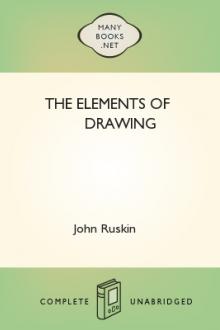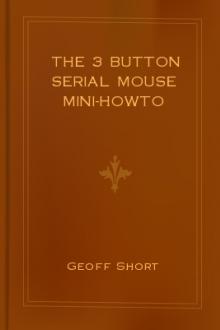The Elements of Drawing by John Ruskin (smart books to read .txt) 📕

xii. One task, however, of some difficulty, the student will find I have not imposed upon him: namely, learning the laws of perspective. It would be worth while to learn them, if he could do so easily; but without a master's help, and in the way perspective is at present explained in treatises, the difficulty is greater than the gain. For perspective is not of the slighte
Read free book «The Elements of Drawing by John Ruskin (smart books to read .txt) 📕» - read online or download for free at americanlibrarybooks.com
- Author: John Ruskin
- Performer: -
Read book online «The Elements of Drawing by John Ruskin (smart books to read .txt) 📕». Author - John Ruskin
EXERCISE V.
Fig. 3. Fig. 3.18. When you can manage to tint and gradate tenderly with the pencil point, get a good large alphabet, and try to tint the letters into shape with the pencil point. Do not outline them first, but measure their height and extreme breadth with the compasses, as a b, a c, Fig. 3, and then scratch in their shapes gradually; the letter A, inclosed within the lines, being in what Turner would have called a "state of forwardness." Then, when you are satisfied with the shape of the letter, draw pen-and-ink lines firmly round the tint, as at d, and remove any touches outside the limit, first with the india-rubber, and then with the penknife, so that all may look clear and right. If you rub out any of the pencil inside the outline of the letter, retouch it, closing it up to the inked line. The straight lines of the outline are all to be ruled,[5] but the curved lines are to be drawn by the eye and hand; and you will soon find what good practice there is in getting the curved letters, such as Bs, Cs, etc., to stand quite straight, and come into accurate form.
19. All these exercises are very irksome, and they are not to be persisted in alone; neither is it necessary to acquire perfect power in any of them. An entire master of the pencil or brush ought, indeed, to be able to draw any form at once, as Giotto his circle; but such skill as this is only to be expected of the consummate master, having pencil in hand all his life, and all day long,—hence the force of Giotto's proof of his skill; and it is quite possible to draw very beautifully, without attaining even an approximation to such a power; the main point being, not that every line should be precisely what we intend or wish, but that the line which we intended or wished to draw should be right. If we always see rightly and mean rightly, we shall get on, though the hand may stagger a little; but if we mean wrongly, or mean nothing, it does not matter how firm the hand is. Do not therefore torment yourself because you cannot do as well as you would like; but work patiently, sure that every square and letter will give you a certain increase of power; and as soon as you can draw your letters pretty well, here is a more amusing exercise for you.
EXERCISE VI.
20. Choose any tree that you think pretty, which is nearly bare of leaves, and which you can see against the sky, or against a pale wall, or other light ground: it must not be against strong light, or you will find the looking at it hurt your eyes; nor must it be in sunshine, or you will be puzzled by the lights on the boughs. But the tree must be in shade; and the sky blue, or gray, or dull white. A wholly gray or rainy day is the best for this practice.
21. You will see that all the boughs of the tree are dark against the sky. Consider them as so many dark rivers, to be laid down in a map with absolute accuracy; and, without the least thought about the roundness of the stems, map them all out in flat shade, scrawling them in with pencil, just as you did the limbs of your letters; then correct and alter them, rubbing out and out again, never minding how much your paper is dirtied (only not destroying its surface), until every bough is exactly, or as near as your utmost power can bring it, right in curvature and in thickness. Look at the white interstices between them with as much scrupulousness as if they were little estates which you had to survey, and draw maps of, for some important lawsuit, involving heavy penalties if you cut the least bit of a corner off any of them, or gave the hedge anywhere too deep a curve; and try continually to fancy the whole tree nothing but a flat ramification on a white ground. Do not take any trouble about the little twigs, which look like a confused network or mist; leave them all out,[6] drawing only the main branches as far as you can see them distinctly, your object at present being not to draw a tree, but to learn how to do so. When you have got the thing as nearly right as you can,—and it is better to make one good study, than twenty left unnecessarily inaccurate,—take your pen, and put a fine outline to all the boughs, as you did to your letter, taking care, as far as possible, to put the outline within the edge of the shade, so as not to make the boughs thicker: the main use of the outline is to affirm the whole more clearly; to do away with little accidental roughnesses and excrescences, and especially to mark where boughs cross, or come in front of each other, as at such points their arrangement in this kind of sketch is unintelligible without the outline. It may perfectly well happen that in Nature it should be less distinct than your outline will make it; but it is better in this kind of sketch to mark the facts clearly. The temptation is always to be slovenly and careless, and the outline is like a bridle, and forces our indolence into attention and precision. The outline should be about the thickness of that in Fig. 4, which represents the ramification of a small stone pine, only I have not endeavored to represent the pencil shading within the outline, as I could not easily express it in a wood-cut; and you have nothing to do at present with the indication of foliage above, of which in another place. You may also draw your trees as much larger than this figure as you like; only, however large they may be, keep the outline as delicate, and draw the branches far enough into their outer sprays to give quite as slender ramification as you have in this figure, otherwise you do not get good enough practice out of them.
Fig. 4. Fig. 4.22. You cannot do too many studies of this kind: every one will give you some new notion about trees. But when you are tired of tree boughs, take any forms whatever which are drawn in flat color, one upon another; as patterns on any kind of cloth, or flat china (tiles, for instance), executed in two colors only; and practice drawing them of the right shape and size by the eye, and filling them in with shade of the depth required.
In doing this, you will first have to meet the difficulty of representing depth of color by depth of shade. Thus a pattern of ultramarine blue will have to be represented by a darker tint of gray than a pattern of yellow.
23. And now it is both time for you to begin to learn the mechanical use of the brush; and necessary for you to do so in order to provide yourself with the gradated scale of color which you will want. If you can, by any means, get acquainted with any ordinary skillful water-color painter, and prevail on him to show you how to lay on tints with a brush, by all means do so; not that you are yet, nor for a long while yet, to begin to color, but because the brush is often more convenient than the pencil for laying on masses or tints of shade, and the sooner you know how to manage it as an instrument the better. If, however, you have no opportunity of seeing how water-color is laid on by a workman of any kind, the following directions will help you:—
EXERCISE VII.
24. Get a shilling cake of Prussian blue. Dip the end of it in water so as to take up a drop, and rub it in a white saucer till you cannot rub much more, and the color gets dark, thick, and oily-looking. Put two teaspoonfuls of water to the color you have rubbed down, and mix it well up with a camel's-hair brush about three quarters of an inch long.
25. Then take a piece of smooth, but not glossy, Bristol board or pasteboard; divide it, with your pencil and rule, into squares as large as those of the very largest chess-board: they need not be perfect squares, only as nearly so as you can quickly guess. Rest the pasteboard on something sloping as much as an ordinary desk; then, dipping your brush into the color you have mixed, and taking up as much of the liquid as it will carry, begin at the top of one of the squares, and lay a pond or runlet of color along the top edge. Lead this pond of color gradually downwards, not faster at one place than another, but as if you were adding a row of bricks to a building, all along (only building down instead of up), dipping the brush frequently so as to keep the color as full in that, and in as great quantity on the paper, as you can, so only that it does not run down anywhere in a little stream. But if it should, never mind; go on quietly with your square till you have covered it all in. When you get to the bottom, the color will lodge there in a great wave. Have ready a piece of blotting-paper; dry your brush on it, and with the dry brush take up the superfluous color as you would with a sponge, till it all looks even.
26. In leading the color down, you will find your brush continually go over the edge of the square, or leave little gaps within it. Do not endeavor to retouch these, nor take much care about them; the great thing is to get the color to lie smoothly where it reaches, not in alternate blots and pale patches; try, therefore, to lead it over the square as fast as possible, with such attention to your limit as you are able to give. The use of the exercise is, indeed, to enable you finally to strike the color up to the limit with perfect





Comments (0)